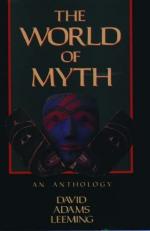
|
| Name: _________________________ | Period: ___________________ |
This test consists of 15 multiple choice questions and 5 short answer questions.
Multiple Choice Questions
1. Whose behavior does Leeming say explains the behavior of the Olympian gods in the Greek pantheon?
(a) The Greek ruling class'.
(b) The Egyptians'.
(c) The Persians'.
(d) The Etruscans'.
2. What does Leeming say the Great Mother personifies?
(a) The pains of childbirth.
(b) The process of being born.
(c) Grains.
(d) The planet earth.
3. To whom does Leeming say the Egyptian god Isis corresponds in the Greek pantheon?
(a) Athena.
(b) Hera.
(c) Demeter.
(d) Persephone.
4. How does Bumba create the earth in Boshongo creation myth?
(a) He vomits it.
(b) He excretes it.
(c) He fashions it from stone.
(d) He finds it.
5. What does Leeming say the Indian creation myths were concerned with?
(a) The variety of forms the creator made.
(b) The emergence of the mind from nothingness.
(c) The insufficiency of the human mind to comprehending creation.
(d) The ability of the human will to make moral decisions.
6. How does Leeming describe the mythic concern with creation?
(a) As a metaphor for history.
(b) As a metaphor for birth.
(c) As a metaphor for storytelling.
(d) As a metaphor for maturity.
7. How does Leeming describe Hopi culture?
(a) As communal.
(b) As patriarchal.
(c) As matrilineal.
(d) As warlike.
8. For what does Leeming say the struggle among gods in the Egyptian pantheon is a metaphor?
(a) The human struggle against evil.
(b) The invasion of Ethiopians in 2,200 BCE.
(c) The expansion of trade in the Mediterranean.
(d) Historical political and religious conflicts in 4,000 BCE.
9. What does Leeming say myths describe with regard to individuals relating to the Supreme Being?
(a) Myths describe the state of formless perfection alongside the Supreme Being.
(b) Myths describe the irreconcilable split that divides humans from the Supreme Being.
(c) Myths describe the rules that govern redemption and grace for humans.
(d) Myths describe the innate unity of each individual with the Supreme Being.
10. What psychological experience does Leeming say is central to cosmogonies?
(a) The rise of consciousness from unconsciousness.
(b) The rise of technology.
(c) The rise of industry from crafts.
(d) The rise of nationalism from tribalism.
11. When was the Book of the Dead made?
(a) 2134 BCE.
(b) 1400 CE.
(c) 1550 BCE.
(d) 1200 CE.
12. When were creation myths repeated in the culture that created the oldest myth Leeming cites?
(a) During rites of passage.
(b) During weddings and births.
(c) During coronations and funerals.
(d) During wars.
13. What does Leeming say dominates all myths?
(a) The concept of God and Goddess.
(b) The concept of creation from nothing.
(c) The concept of redemption.
(d) The concept of justice in the universe.
14. What does Leeming say Isis is the goddess of?
(a) The hearth.
(b) Crossroads.
(c) The earth and moon.
(d) Birth.
15. How does Leeming say earth religions still worship the Great Mother?
(a) In the seasons.
(b) In the constellations.
(c) In the form of nature.
(d) In modern agriculture.
Short Answer Questions
1. What other divine figure does Leeming say the main Norse god resembles?
2. Who does Leeming say is the archetypal helper god in the Greco-Roman Pantheon?
3. What evidence does Leeming cite that suggests the presence of whites in Africa?
4. How does Leeming describe the trickster gods?
5. When does Leeming say the older Genesis text was likely composed?
|
This section contains 526 words (approx. 2 pages at 300 words per page) |

|




